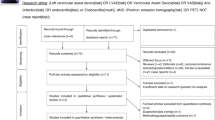Abstract
Background
Quantitative assessment of [18F]-FDG PET/CT images has been shown to be useful in the diagnosis of cardiac implantable electronic device (CIED) infection. This study aimed to compare the accuracy of various quantitative methods, using the same patient cohort and to assess the utility of dual time point imaging.
Methods
The study comprised a retrospective review of 80 [18F]-FDG PET/CT studies. Of these, 41 were oncological patients with an asymptomatic CIED in situ (Group 1), and 39 were studies performed in patients with symptomatic devices. Of these, 14 were subsequently deemed on follow-up to be non-infected (Group 2), and 25 confirmed as infected post-device extraction (Group 3). Ratios of maximal uptake around the CIED in both the attenuation corrected and non-attenuation corrected images were calculated to regions of normal physiological uptake, along with the maximal standardized uptake value (SUVmax) alone. Receiver operating characteristic analysis was performed for all methods at both time points. Measurement reliability was assessed using the intraclass correlation coefficient (ICC).
Results
Using Group 1 as a reference, all methods gave an area under the curve (AUC) greater than 0.93. Using Group 2 as reference, the accuracy varied greatly, with AUC values ranging from 0.71 to 0.97. The hepatic blood pool (HBP) ratio gave the highest AUC values. The calculated ICC values for each method showed the SUVmax and HBP measurement to have the greatest reliability, with values of 1.0 and 0.97, respectively.
Conclusions
Quantitation of [18F] FDG uptake was found to have a high degree of accuracy in confirming the diagnosis of CIED infection. Normalization to HBP uptake was found to give the greatest AUC and demonstrated excellent reliability. Inconsistencies from published data indicate that individual imaging centers should only use published data for guidance.



Similar content being viewed by others
References
Greenspon AJ, Patel JD, Lau E, Ochoa JA, Frisch DR, Ho RT, et al. 16-year trends in the infection burden for pacemakers and implantable cardioverter-defibrillators in the United States: 1993 to 2008. J Am Coll Cardiol 2011;58:1001-6.
Voigt A, Shalaby A, Saba S. Continued rise in rates of cardiovascular implantable electronic device infections in the United States: Temporal trends and causative insights. Pacing Clin Electrophysiol 2010;33:414-9.
Margey R, McCann H, Blake G, Keelan E, Galvin J, Lynch M, et al. Contemporary management of and outcomes from cardiac device related infections. Europace 2010;12:64-70.
Ipek EG, Guray U, Demirkan B, Guray Y, Aksu T. Infections of implantable cardiac rhythm devices: Predisposing factors and outcome. Acta Cardiol 2012;67:303-10.
Maytin M, Jones SO, Epstein LM. Long-term mortality after transvenous lead extraction. Circulation 2012;5:252-7.
Vos FJ, Bleeker-Rovers CP, van Dijk APJ, Oyen WJG. Detection of pacemaker and lead infection with FDG-PET. Eur J Nucl Med Mol Imaging 2006;33:1245.
Ploux S, Riviere A, Amraoui S, Whinnett Z, Barandon L, Lafitte S, et al. Positron emission tomography in patients with suspected pacing system infections may play a critical role in difficult cases. Heart Rhythm 2011;8:1478-81.
Brinker J. Imaging for infected cardiac implantable electronic devices: A new trick for your pet. J Am Coll Cardiol 2012;59:1626-8.
Bensimhon L, Lavergne T, Hugonnet F, Mainardi JL, Latremouille C, Maunoury C, et al. Whole body [(18)F]fluorodeoxyglucose positron emission tomography imaging for the diagnosis of pacemaker or implantable cardioverter defibrillator infection: A preliminary prospective study. Clin Microbiol Infect 2011;17:836-44.
Sarrazin J-F, Philippon F, Tessier M, Guimond J, Molin F, Champagne J, et al. Usefulness of fluorine-18 positron emission tomography/computed tomography for identification of cardiovascular implantable electronic device infections. J Am Coll Cardiol 2012;59:1616-25.
Cautela J, Alessandrini S, Cammilleri S, Giorgi R, Richet H, Casalta JP, et al. Diagnostic yield of FDG positron-emission tomography/computed tomography in patients with CEID infection: a pilot study. Europace 2013;15:252-7.
Ahmed FZ, James J, Tout D, Arumugam P, Mamas M, Zaidi AM. Metal artefact reduction algorithms prevent false positive results when assessing patients for cardiac implantable electronic device infection. J Nucl Cardiol 2014;22:219-20.
Abdoli M, De R, Dierckx RAO, Zaidi H, Member S. Clough-Tocher interpolation of virtual sinogram in a Delaunay triangulated grid for metal artifact reduction of PET/CT images. 2011 IEEE nuclear science symposium and medical imaging conference (NSS/MIC); 2011. p. 3197-3201.
Meignan M, Gallamini A, Haioun C. Report on the first international workshop on Interim-PET-scan in lymphoma. Leuk Lymphoma 2009;50:1257-60.
Wahl RL, Jacene H, Kasamon Y, Lodge MA. From RECIST to PERCIST: Evolving considerations for PET response criteria in solid tumors. J Nucl Med 2009;50:122S-50S.
DeLong ER, DeLong DM, Clarke-Pearson DL. Comparing the areas under two or more correlated receiver operating characteristic curves: A nonparametric approach. Biometrics 1988;44:837-45.
Shrout PE, Fliess JL. Intraclass correlations: Uses in assessing rater reliability. Psychol Bull 1979;86:420-8.
Cheng G, Alavi A, Lim E, Werner TJ, Del Bello CV, Akers SR. Dynamic changes of FDG uptake and clearance in normal tissues. Mol Imaging Biol 2013;15:345-52.
Leccisotti L, Perna F, Lago M, Leo M, Stefanelli A, Calcagni ML, et al. Cardiovascular implantable electronic device infection: Delayed vs standard FDG PET-CT imaging. J Nucl Cardiol 2014;21:622-32.
Disclosure
The authors have indicated that they have no financial conflict of interest.
Author information
Authors and Affiliations
Corresponding author
Additional information
See related editorial, doi:10.1007/s12350-015-0293-2.
Rights and permissions
About this article
Cite this article
Memmott, M.J., James, J., Armstrong, I.S. et al. The performance of quantitation methods in the evaluation of cardiac implantable electronic device (CIED) infection: A technical review. J. Nucl. Cardiol. 23, 1457–1466 (2016). https://doi.org/10.1007/s12350-015-0106-7
Received:
Accepted:
Published:
Issue Date:
DOI: https://doi.org/10.1007/s12350-015-0106-7




